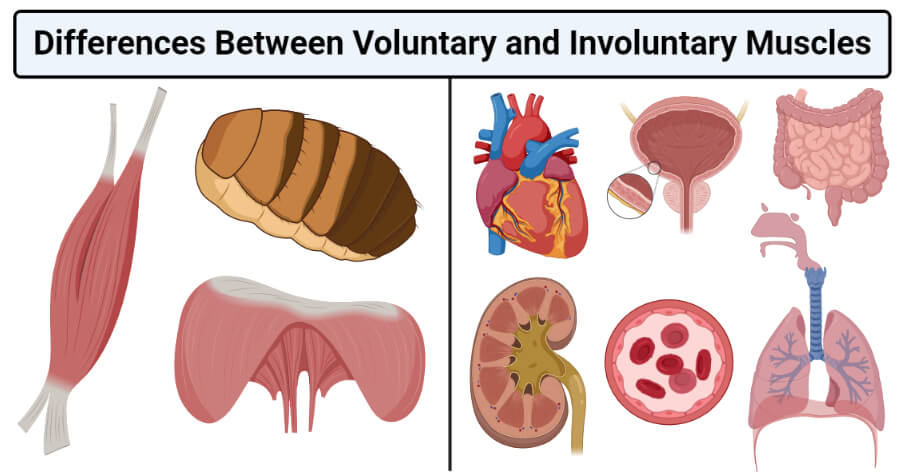What Term Is Used to Describe Involuntary Muscle Movements
Athetosis is slow writhing continuous and involuntary movements of the extremities. Bradykinesia is the term used to describe the impaired ability to adjust to ones body position.

Voluntary Vs Involuntary Muscles Definition 16 Differences Examples
The involuntary movements of dystonia and athetosis are similar and the use of one term rather than the other often seems more a matter of situation and semantics than of physiology.

. Involuntary contraction of opposing muscle groups resulting in rhythmic movement of one or more joints. Eye movement includes the voluntary or involuntary movement of the eyes helping in acquiring fixating and tracking visual stimuli. Absence of muscle movement suggesting nerve damage.
The sudden involuntary jerking of a muscle or group of muscles is referred to as. 27 The movements are typically slow but can be quick and may be sustained for a second or longer when the involuntary contraction is at its maximum. Dyskinesia is a blanket term used to describe involuntary uncontrollable movements.
The term hemichorea refers to chorea of one side of the body such as chorea of one arm but not both. Automatic associated movements of the body are under the control and regulation of. A stiff neck due to spasmodic contraction of the neck muscles that pull the head toward the affected side.
This page describes the diagnosis of the major categories of hyperkinetic movement disorders. In rare cases a tremor in the muscles located in an individuals chest mouth or abdomen may be the cause of their vocal tremor. It may be instigated by a voluntary movement.
This symptom is noted in patients who have Parkinsons disease. Ability to distinguish the separation of two simultaneous pinpricks on the skin. Clonus that may be seen when testing deep tendon reflexes is characterized by.
This type of involuntary muscle movement is typified by a muscle contraction that lasts for a prolonged period. Smooth muscles are the involuntary muscles that control the movements and actions of the internal organs and systems of the body. What term is used to describe involuntary muscle movements.
A Ataxia B Flaccidity C Athetosis D Vestibular function. The term chorea is derived from the Ancient Greek. Term used to describe involuntary muscle movements.
Repetitive twitching of a muscle group at inappropriate times wink grimace tremor. Involuntary movements compose a group of uncontrolled movements that may manifest as a tremor tic myoclonic jerk chorea athetosis dystonia or hemiballism. It can comprise of repetitive and twisting motions that form irregular postures.
A special type of eye movement rapid eye movement occurs during REM sleep. For example smooth muscles with nervous system activity perform peristalsis in the gastrointestinal system to move food and digested food along the gastrointestinal to the anus. These movements typically involve the face and mouth although they may occur in any body part.
A sudden violent involuntary contraction of a muscle or a group of muscles. It can involve a single muscle group or several muscle groups. Myoclonus A condition in which a person experiences slight paralysis or weakness affecting one side of the body is known as.
Set of rapid rhythmic contractions of the same muscle. The term used to describe involuntary muscle spasms twisting of the limbs is. Recognition of involuntary movements associated with hyperkinetic movement disorders is an important diagnostic skill.
Testing the deep tendon reflexes gives the examiner information regarding the intactness of the. The absence of muscle tone suggesting nerve damage is referred to as paralysis. This can happen side to side up and down and in a rotary direction.
Tardive dyskinesia is a general term referring to involuntary movements that are induced by medications usually major tranquilizers such as haloperidol Haldol. Paresthesia is the term used to refer to. The term used to describe involuntary eye movements is nystagmus.
Also known as wryneck. Chorea is an abnormal involuntary movement disorder one of a group of neurological disorders called dyskinesias. Abnormal sensations such as burning tingling and numbness are referred to as paresthesias.
Neuromuscular disease is an encompassing term used to describe a group of diseases that primarily cause problems with the nerves responsible for controlling voluntary muscle movement and the nerves responsible for sending sensory information to the brain. Dystonia is a neurological disorder that causes involuntary muscle spasms twisting of the limbs. Shaking voice and vocal tremor are terms used to describe when an individual experiences involuntary movements of the muscles located in their throat vocal cords and voice box.
Most neuromuscular diseases involve progressive muscle fatigue and weakness. Also known as cramp. The eyes are the visual organs of the human body and move using a system of six musclesThe retina a specialised type of tissue containing photoreceptors senses light.
χορεία as the quick movements of the feet or hands are comparable to dancing. Dystonia is the term used to describe a movement disorder characterized by involuntary muscle spasms. These spasms can affect different areas of the body and often force certain parts of the body into abnormal movements and postures some of which are painful.
Involuntary twitch of muscle fibers. What term is used to describe involuntary muscle movements.

Muscle Names Movement Ppt Download
/involuntary-movement-5187794.FINAL-9de251a0f498416b8076299363531c38.gif)
No comments for "What Term Is Used to Describe Involuntary Muscle Movements"
Post a Comment